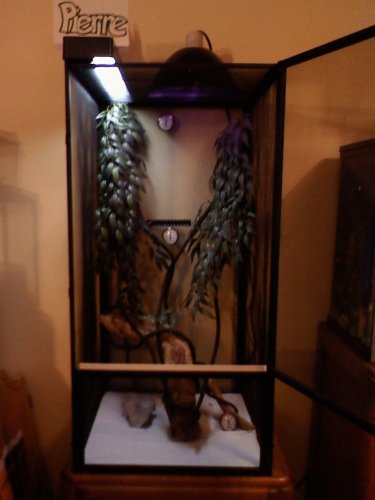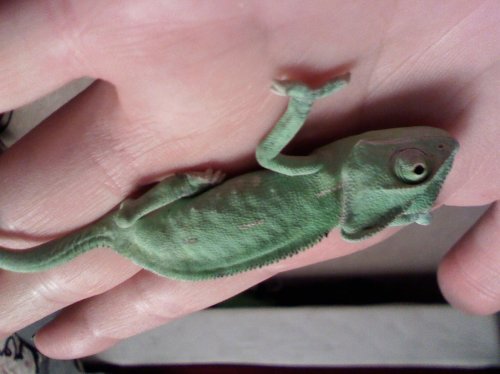TheFrenchChameleon
New Member
Name: Pierre
Species: Veiled Chameleon
Sex: Male
Age: about 4.5 months, we’ve had him since he was about 1.5 months old
Handling: once a week at the most before he started having issues, now it’s a couple of times a day
Feeding: Pierre eats gut loaded crickets, sometimes he eats small mealworms. He has a constant supply of small crickets, we buy them gut-loaded, keep them in container with veggies, usually some potato.
Supplements: We recently got Tetrafauna ReptoCal which we’ve started using once a week on a few crickets, unfortunately if he doesn’t eat them right away they die from the dusting. It seems the best way to make sure he eats the calcium dusted ones is to feed him from our hands.
We also have Zilla humidifying spray that we spray him with once a day and also mist the terrarium.
Watering: We mist down the terrarium 3 or so times a day for a minute each, depending on if we’ve seen him drink yet or not.
Fecal Description: He has never been tested for parasites. His feces looks like a brown solid and white liquid.
History: My boyfriends brother bought Pierre randomly one night mid-September with really no intention of being a responsible owner. We’ve adopted him and have been doing the best we can, constantly researching how to care for him. He is our first chameleon, we also own a Ball Python, Red-tailed boa constrictor and Leopard Gecko. We moved into our new, smoke-free apartment Nov. 21st.
Cage Type: Zoo Med ReptiBreeze, all screen, 18" x 18" x 36".
Lighting: Zilla Slimline Desert 50 UVB T8 Fluorescent Fixture, 15watt. Daytime heat lamp is a Zoo Med 150watt Basking Spot Lamp. Night heat lamp is a Zilla 75watt Incandescent Night Black Heat Spot light. The UVB and daytime bulb go on at 8:30am and off at 8:30pm.
Temperature: Day- temp range (top to bottom) 90F, 85F, and 80F
Night- temp range (top to bottom) 85F, 78F, and 75F.
We have 3 temperature gauges, top, middle and bottom.
Humidity: 55% in between mistings, spikes up to 65%-75% during mistings (3+ times a day). We have a humidity gauge at the center of the terrarium.
Plants: We have 2 fake plants, a big log and 5 vines.
Placement: The cage is in our living room, there are no fans or vents nearby. As far as high traffic, it’s only my boyfriend, dog, and I. There’s never much activity going on. The top of the cage is 5ft off the floor.
Location: We are located in Vermont.
Current Problem: Up until about a week ago, Pierre seemed absolutely fine, he was hunting/eating crickets all on his own, climbing all over the place. Now, Pierre is lethargic, very clumsy, falls a lot, unable to climb/grip, very weak, tries to eat small crickets but can’t hold them in his mouth, they push their way out, sleeps during the day, puts his left hand on his eye/nostril a lot. He also hasn’t grown at all since we adopted him. We think the issue may be a lack of calcium; we just started really pushing the reptiCal yesterday. I coat a cricket it in and then hand feed it to him so it doesn’t get away and die from the calcium. Any suggestions on how to nurse him back to health would be greatly appreciated. Also any suggested schedule on using the calcium, including how many calcium coated crickets per week he should be getting. Any tips you can give us would be great, we’re constantly learning new things Pierre needs, he’s far more complicated than a snake.
Species: Veiled Chameleon
Sex: Male
Age: about 4.5 months, we’ve had him since he was about 1.5 months old
Handling: once a week at the most before he started having issues, now it’s a couple of times a day
Feeding: Pierre eats gut loaded crickets, sometimes he eats small mealworms. He has a constant supply of small crickets, we buy them gut-loaded, keep them in container with veggies, usually some potato.
Supplements: We recently got Tetrafauna ReptoCal which we’ve started using once a week on a few crickets, unfortunately if he doesn’t eat them right away they die from the dusting. It seems the best way to make sure he eats the calcium dusted ones is to feed him from our hands.
We also have Zilla humidifying spray that we spray him with once a day and also mist the terrarium.
Watering: We mist down the terrarium 3 or so times a day for a minute each, depending on if we’ve seen him drink yet or not.
Fecal Description: He has never been tested for parasites. His feces looks like a brown solid and white liquid.
History: My boyfriends brother bought Pierre randomly one night mid-September with really no intention of being a responsible owner. We’ve adopted him and have been doing the best we can, constantly researching how to care for him. He is our first chameleon, we also own a Ball Python, Red-tailed boa constrictor and Leopard Gecko. We moved into our new, smoke-free apartment Nov. 21st.
Cage Type: Zoo Med ReptiBreeze, all screen, 18" x 18" x 36".
Lighting: Zilla Slimline Desert 50 UVB T8 Fluorescent Fixture, 15watt. Daytime heat lamp is a Zoo Med 150watt Basking Spot Lamp. Night heat lamp is a Zilla 75watt Incandescent Night Black Heat Spot light. The UVB and daytime bulb go on at 8:30am and off at 8:30pm.
Temperature: Day- temp range (top to bottom) 90F, 85F, and 80F
Night- temp range (top to bottom) 85F, 78F, and 75F.
We have 3 temperature gauges, top, middle and bottom.
Humidity: 55% in between mistings, spikes up to 65%-75% during mistings (3+ times a day). We have a humidity gauge at the center of the terrarium.
Plants: We have 2 fake plants, a big log and 5 vines.
Placement: The cage is in our living room, there are no fans or vents nearby. As far as high traffic, it’s only my boyfriend, dog, and I. There’s never much activity going on. The top of the cage is 5ft off the floor.
Location: We are located in Vermont.
Current Problem: Up until about a week ago, Pierre seemed absolutely fine, he was hunting/eating crickets all on his own, climbing all over the place. Now, Pierre is lethargic, very clumsy, falls a lot, unable to climb/grip, very weak, tries to eat small crickets but can’t hold them in his mouth, they push their way out, sleeps during the day, puts his left hand on his eye/nostril a lot. He also hasn’t grown at all since we adopted him. We think the issue may be a lack of calcium; we just started really pushing the reptiCal yesterday. I coat a cricket it in and then hand feed it to him so it doesn’t get away and die from the calcium. Any suggestions on how to nurse him back to health would be greatly appreciated. Also any suggested schedule on using the calcium, including how many calcium coated crickets per week he should be getting. Any tips you can give us would be great, we’re constantly learning new things Pierre needs, he’s far more complicated than a snake.






